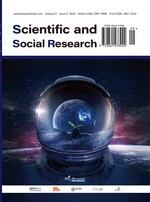Abstract
The hypothesis of this study proposes that the expansion of the universe may be caused by gravitational differentials rather than dark energy. It is assumed that there are one or more gravitational centers outside the visible universe. Since the visible universe is not located at the center of gravity of the gravitational center, the gravitational forces on celestial bodies in different regions are different, forming an acceleration difference, which causes the celestial bodies to move relatively far away, thus causing expansion. The hypothesis derives the conditions for the expansion to occur: when the gravitational differential exerted by the gravitational center on the celestial body is greater than the gravitational force between them, the expansion effect occurs. In addition, it is assumed that the displacement relationship between the visible universe and the gravitational center can be revealed through the change of the Hubble constant, including rotation around the gravitational center, falling into or leaving. Although this hypothesis is different from the dark energy hypothesis, it does not deny the existence of dark energy. It is believed that gravitational differentials and dark energy may work together to explain the accelerated expansion of the universe. This theory provides another possibility for the expansion of the universe, which needs to be verified by observation.
References
Ranzan C, 2016, The Nature of Gravitational Collapse. American Journal of Astronomy and Astrophysics, 4(2): 15–33.
Thalman B, 2023, Gravity is not Attraction; It’s a Push (Space-Time Expansion Theory). Open Journal of Philosophy, 13(01): 48–75.
Seoane PA, Aoudia S, Audley H, et al., 2013, The Gravitational Universe, report, Albert Einstein Institute, 1305.5720.
Ni WT, 2017, One Hundred Years of General Relativity: From Genesis and Empirical Foundations to Gravitational Waves, Cosmology and Quantum Gravity, Volume 2. World Scientific, Singapore.
Bouche F, Capozziello S, Salzano V, 2022, Addressing Cosmological Tensions by non-Local Gravity. Universe, 9(1): 27.
Ranzan C, 2018, The Nature of Gravity: How One Factor Unifies Gravity’s Convergent, Divergent, Vortex, and Wave Effects. International Journal of Astrophysics and Space Science, 6(5): 73–92.
Li B, Shapiro PR, 2021, Precision Cosmology and the Stiff-amplified Gravitational: Wave Background from Inflation: NANOGrav, Advanced LIGO-Virgo and the Hubble Tension. Journal of Cosmology and Astroparticle Physics, 2021(10): 24.
Netchitailo V, 2022, Paradigm Shift for Cosmology and Classical Physics, unpublished draft.
Ranzan C, 2018, Natural Mechanism for the Generation and Emission of Extreme Energy Particles. Physics Essays, 31(3): 358–376.
Papanikolaou T, 2022, Gravitational Waves Induced from Primordial Black Hole Fluctuations: The Effect of an Extended Mass Function. Journal of Cosmology and Astroparticle Physics, 2022(10): 89.
Du H, 2021, Observation of Astronomical Antigravity: Origin of Astronomical Jets, Black Hole Radiation, Cosmic Gamma Ray, Fast Radio Burst, Supernova Explosion and Many More, preprint.
Netchitailo VS, 2021, Decisive Role of Dark Matter in Cosmology. Journal of High Energy Physics, Gravitation and Cosmology, 8(1): 115–142.
Cooper K, 2020, Origins of the Universe: The Cosmic Microwave Background and the Search for Quantum Gravity. Icon Books, London.
Netchitailo VS, 2022, Cosmology and Classical Physics. Journal of High Energy Physics, Gravitation and Cosmology, 8(4): 1037–1072.
Erickcek AL, 2009, The Consequences of Modifying Fundamental Cosmological Theories, thesis, California Institute of Technology.
Wick M, 2015, Megaphysics II; An Explanation of Nature: The Equation of Everything in Terms of Cosmology, Strings and Relativity. AuthorHouse, Indiana.
Baker T, Barreira A, Desmond H, et al., 2021, Novel Probes Project: Tests of Gravity on Astrophysical Scales. Reviews of Modern Physics, 93(1): 015003.
Vijaykumar A, 2024, Exploring Gravity, Astrophysics, and Cosmology with Gravitational Waves, thesis, Tata Institute of Fundamental Research.
Cardenas-Avendano A, Sopuerta CF, 2024, Testing Gravity with Extreme-mass-ratio Inspirals, in Recent Progress on Gravity Tests: Challenges and Future Perspectives. Springer Nature Singapore, Singapore, 275–359.
Pitkanen M, 2019, Cosmic String Model for the Formation of Galaxies and Stars. https://tgdtheory.fi/public_html/articles/galaxystars.pdf
Netchitailo VS, 2021, Paradigm Shift in Cosmology, preprint.
Lou YQ, Shen W, 2021, Dynamic Spherical Collapses towards Growing Black Holes in Relativistically Degenerate or Hot Host Mass Reservoirs. Monthly Notices of the Royal Astronomical Society, 506(4): 6125–6143.
Sakharov AS, Eroshenko YN, Rubin SG, 2021, Looking at the NANOGrav Signal through the Anthropic Window of Axionlike Particles. Physical Review D, 104(4): 043005.
Van PMH, Levinson A, 2012, Relativistic Astrophysics of the Transient Universe: Gravitation, Hydrodynamics and Radiation. Cambridge University Press, Cambridge.
Van PMH, Levinson A, Frontera F, et al., 2019, Prospects for Multi-messenger Extended Emission from Core-collapse Supernovae in the Local Universe. The European Physical Journal Plus, 134(10): 537.
Colpi M, Sesana A, 2017, Gravitational Wave Sources in the Era of Multi-band Gravitational Wave Astronomy, in An Overview of Gravitational Waves: Theory, Sources and Detection. World Scientific, Singapore, 43–140.
